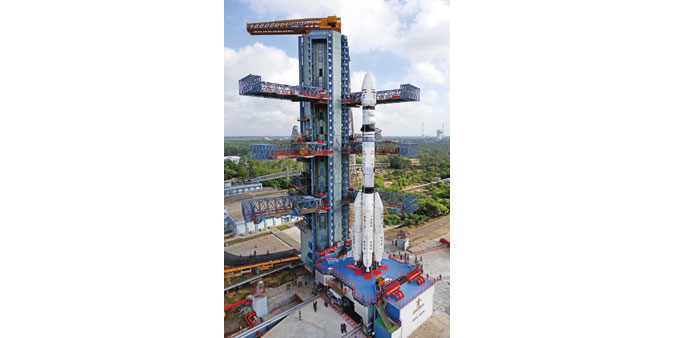IANS/Chennai
The 29-hour countdown for the launch of India’s heavy rocket geosynchronous satellite launch vehicle-D6 (GSLV-D6) carrying communication satellite GSAT-6 with strategic use began yesterday 11.52am at the Sriharikota rocket port in Andhra Pradesh, officials said.
According to Indian Space Research Organisation (ISRO) officials, the countdown began as scheduled.
On Monday, ISRO’s Mission Readiness Review Committee and the Launch Authorisation Board (LAB) cleared the launch for today evening.
The communication satellite will be launched with ISRO’s heavier rocket GSLV.
According to ISRO, the 49.1m tall and 416 tonne GSLV rocket will blast off at 4.52pm today from the second launch pad. Seventeen minutes into the flight the rocket will put into orbit the GSAT-6 communication satellite weighing 2,117 kg.
The GSLV is a three stage/engine rocket. The first stage is fired with solid fuel, the second with liquid fuel and the third is the cryogenic engine.
Indian space agency is flying the GSLV rocket with its own cryogenic engine for the second time on Thursday after the successful launch of similar rocket in January 2014 that put into orbit GSAT-14.
A cryogenic engine is more efficient as it provides more thrust for every kilogram of propellant burnt.
The satellite GSAT-6 is India’s 25th geostationary communication satellite and twelfth in the GSAT series.
Five of GSAT-6’s predecessors were launched by GSLV during 2001, 2003, 2004, 2007 and 2014 respectively.
After its commissioning, GSAT-6 will join the group of India’s other operational geostationary satellites.
The satellite provides communication through five spot beams in S-band and a national beam in C-band for strategic users.
The cuboid shaped GSAT-6 has a lift-off mass of 2,117kg. Of this, propellants weigh 1,132kg and the dry mass of the satellite is 985kg.
One of the advanced features of GSAT-6 satellite is its 6m diameter S-Band Unfurlable Antenna.
This is the largest satellite antenna realised by ISRO. This antenna is utilised for five spot beams over the Indian main land.
The spot beams exploit the frequency reuse scheme to increase frequency spectrum utilisation efficiency.

A view of ISRO’s GSLV-D6 that is scheduled to carry the GSAT-6 at Sriharikota rocket port of the Satish Dhawan Space Centre. The launch is scheduled f


